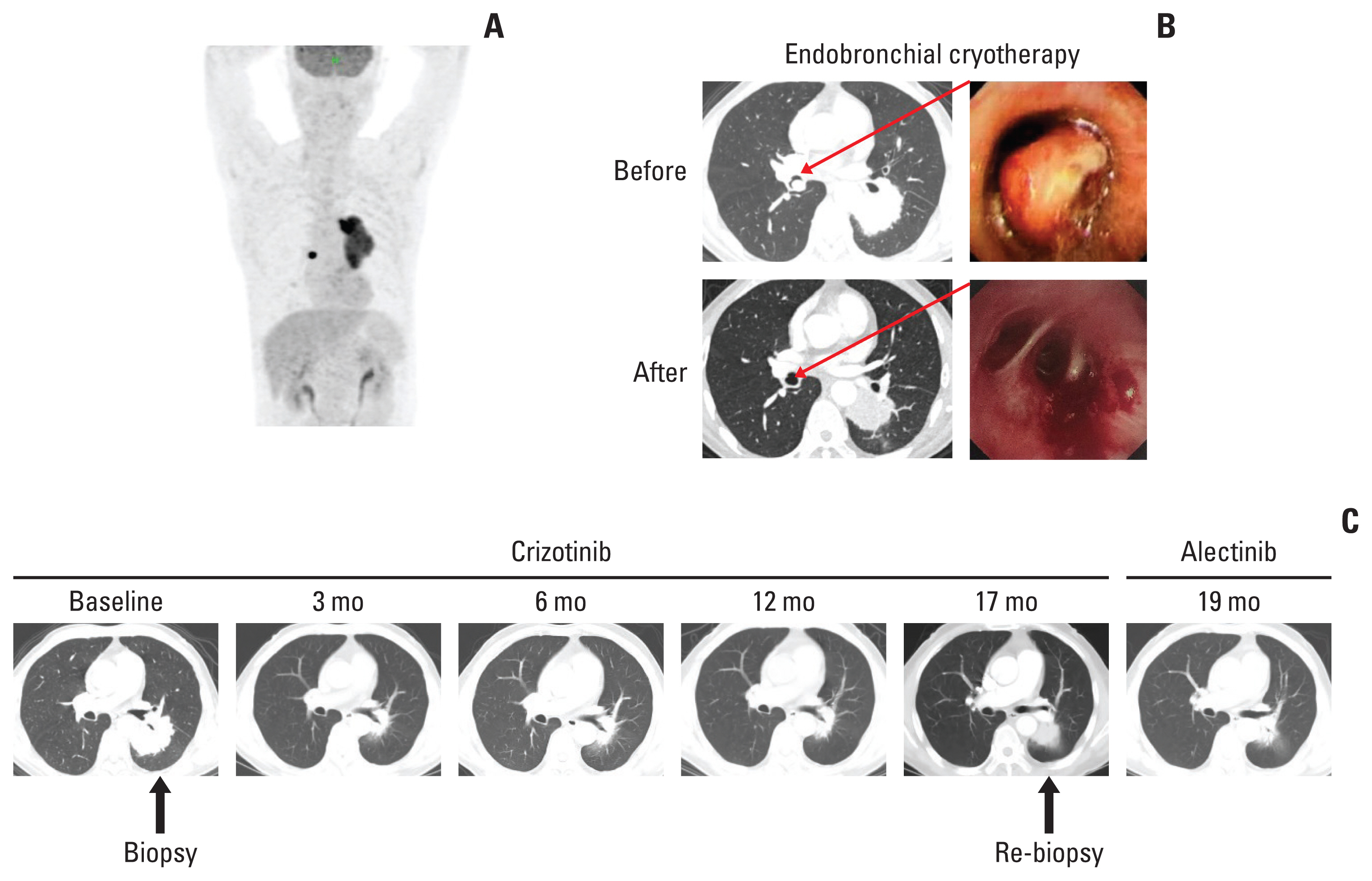Cancer Res Treat.
2021 Apr;53(2):601-606. 10.4143/crt.2020.952.
A Case of Simultaneously Diagnosed Lung Adenocarcinoma and Endobronchial Inflammatory Myofibroblastic Tumor with Two Distinct Types of ALK Translocation
- Affiliations
-
- 1Department of Lung Cancer Surgery, Tianjin Medical University General Hospital, Tianjin, China
- 2Tianjin Key Laboratory of Lung Cancer Metastasis and Tumor Microenvironment, Lung Cancer Institute, Tianjin Medical University General Hospital, Tianjin, China
- 3Department of Respiratory Medicine, Second Affiliated Hospital of Tianjin University of Traditional Chinese Medicine, Tianjin, China
- 4Department of Respiratory and Critical Care, Tianjin Medical University General Hospital, Tianjin, China
- 5Precision Medicine Center, Tianjin Medical University General Hospital, Tianjin, China
- 6Department of PET/CT Diagnostic, Tianjin Medical University General Hospital, Tianjin, China
- 7Department of Pathology, Tianjin Medical University Cancer Institute and Hospital, Tianjin, China
- 8Department of Thoracic Oncology, Tianjin Medical University Cancer Institute and Hospital, Tianjin, China
- KMID: 2514941
- DOI: http://doi.org/10.4143/crt.2020.952
Abstract
- A 61-year-old male patient was simultaneously diagnosed with lung adenocarcinoma and inflammatory myofibroblastic tumor (IMT). The lung adenocarcinoma and IMT harbored two distinct types of ALK translocation, LOC101927285-ALK, and TPM3-ALK, respectively. The ALK Ventana showed strong positivity on both lesions. The patient was therefore given an endobronchial cryotherapy and ALK inhibitor crizotinib. The tumors showed durable response however the left lung adenocarcinoma relapsed at 17th month post-crizotinib treatment. Tissue re-biopsy on the resistant tumor revealed an ALK exon 23 C1156Y missense mutation in addition to LOC101927285-ALK mutation. Further RNA-based sequence uncovered that the noncoding region rearrangement is the fusion mutation of EML4-ALK. The patient was therefore received alectinib, and the tumor exhibited partly response. Overall, it is very rare that two types of pulmonary tumors exist in one patient driven by two distinct ALK fusions, which emphasizes the necessity of gene sequencing in clinical decision-making and individualized therapy.
Keyword
Figure
Reference
-
References
1. Shackelford RE, Vora M, Mayhall K, Cotelingam J. ALK-rearrangements and testing methods in non-small cell lung cancer: a review. Genes Cancer. 2014; 5:1–14.
Article2. Butrynski JE, D’Adamo DR, Hornick JL, Dal Cin P, Antonescu CR, Jhanwar SC, et al. Crizotinib in ALK-rearranged inflammatory myofibroblastic tumor. N Engl J Med. 2010; 363:1727–33.3. Montgomery EA, Shuster DD, Burkart AL, Esteban JM, Sgrignoli A, Elwood L, et al. Inflammatory myofibroblastic tumors of the urinary tract: a clinicopathologic study of 46 cases, including a malignant example inflammatory fibrosarcoma and a subset associated with high-grade urothelial carcinoma. Am J Surg Pathol. 2006; 30:1502–12.
Article4. Mansfield AS, Murphy SJ, Harris FR, Robinson SI, Marks RS, Johnson SH, et al. Chromoplectic TPM3-ALK rearrangement in a patient with inflammatory myofibroblastic tumor who responded to ceritinib after progression on crizotinib. Ann Oncol. 2016; 27:2111–7.
Article5. Kazandjian D, Blumenthal GM, Chen HY, He K, Patel M, Justice R, et al. FDA approval summary: crizotinib for the treatment of metastatic non-small cell lung cancer with anaplastic lymphoma kinase rearrangements. Oncologist. 2014; 19:e5–11.
Article6. Du X, Shao Y, Qin HF, Tai YH, Gao HJ. ALK-rearrangement in non-small-cell lung cancer (NSCLC). Thorac Cancer. 2018; 9:423–30.
Article7. Camidge DR, Bang YJ, Kwak EL, Iafrate AJ, Varella-Garcia M, Fox SB, et al. Activity and safety of crizotinib in patients with ALK-positive non-small-cell lung cancer: updated results from a phase 1 study. Lancet Oncol. 2012; 13:1011–9.
Article8. Dono M, Angelini G, Cecconi M, Amaro A, Esposito AI, Mirisola V, et al. Mutation frequencies of GNAQ, GNA11, BAP1, SF3B1, EIF1AX and TERT in uveal melanoma: detection of an activating mutation in the TERT gene promoter in a single case of uveal melanoma. Br J Cancer. 2014; 110:1058–65.
Article
- Full Text Links
- Actions
-
Cited
- CITED
-
- Close
- Share
- Similar articles
-
- Inflammatory Myofibroblastic Tumor of Nasal Septum after Septoplasty: A Case Report
- An Endobronchial Inflammatory Myofibroblastic Tumor Treated by Modified Left One-stoma-type Carinoplasty
- Endobronchial Inflammatory Myofibroblastic Tumor of Right Lower Lobar Bronchus
- Primary epithelioid inflammatory myofibroblastic sarcoma of the brain with EML4::ALK fusion mimicking intra-axial glioma: a case report and brief literature review
- Clinicopathological Study of 18 Cases of Inflammatory Myofibroblastic Tumors with Reference to ALK-1 Expression: 5-Year Experience in a Tertiary Care Center




